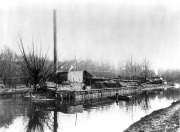|
| |||||
Austin Powder Company
From Brooklyn Centre Wiki
| Line 1: | Line 1: | ||
[[Image:Austin_Powder.jpg|thumb|Austin Powder Co. in 1870]] | [[Image:Austin_Powder.jpg|thumb|Austin Powder Co. in 1870]] | ||
| - | The firm, formerly known as the Cleveland Powder Company, was purchased in 1867 by the Austin brothers of Wilmington, Vermont. The purchase covered 400 acres, some of which would later be the sites of Alcoa Aluminum and Republic Steel. The powder mill was located at the Five Mile Lock on the Ohio Canal. This was where Harvard Road descended down the hill towards Jennings Road. | + | The firm, formerly known as the Cleveland Powder Company, was purchased in 1867 by the Austin brothers of Wilmington, Vermont. The purchase covered 400 acres, some of which would later be the sites of Alcoa Aluminum and Republic Steel. The powder mill was located at the [[Five Mile Lock]] on the [[Ohio Canal]]. This was where Harvard Road descended down the hill towards Jennings Road. |
:Three men died in the blast: | :Three men died in the blast: | ||
Revision as of 19:31, 13 March 2007
The firm, formerly known as the Cleveland Powder Company, was purchased in 1867 by the Austin brothers of Wilmington, Vermont. The purchase covered 400 acres, some of which would later be the sites of Alcoa Aluminum and Republic Steel. The powder mill was located at the Five Mile Lock on the Ohio Canal. This was where Harvard Road descended down the hill towards Jennings Road.
- Three men died in the blast:
- Frederick Putnam
- David Lamson
- August Radcliffe
It was the scene of a powerful explosion in March of 1875. In all, fourteen mills blew up that day. The following are some reports made in the days following the explosion.
"The Austin powder works, five miles from Cleveland, Ohio, blew up yesterday with a series of loud explosions, and the ten or twelve buildings were completely demolished, and three men killed. Windows in Cleveland were shattered, and houses shaken as if by an earthquake, and terrible excitement existed for a while."
"Brooklyn Daily Eagle", Brooklyn, NY, March 17, 1875
"...the scene of the fearful catastrophe in [March]. Some thirty or forty tons of powder blew up, shattering windows and injuring walls from five to ten miles distant. It rung a farm bell forty miles off. Was plainly felt near Pittsburgh one hundred miles off, and yet some houses quite near to the disaster were not injured, and people not over two miles south did not hear or know it. The explanation is in the state of the wind and the situation of the mills. The mills are in a ravine, perhaps sixty to eighty feet below the general level of the country. The force of the explosion followed down the ravine to some extent as if fired in that direction. But probably the wind had the most to do with the result. It was a day of fearful wind, gusty and violent so as to make it dangerous to roofs and houses."
--"The Diary and Letters of Rutherford B. Hayes, Nineteenth President of the United States", edited by Charles Richard Williams (Columbus, Ohio: Ohio State Archeological and Historical Society, 1922), Chapter 31
TERRIFIC EXPLOSION IN CLEVELAND
Three Men Torn into Atoms
"At one o'clock on Tuesday afternoon of last week, the citizens of Cleveland were startled by a shock which caused the strongest buildings to tremble, followed by another, and another, in rapid succession, until four distinct shocks were felt. For a moment the terrified inmates of the buildings thought they were visited by an eartquake direct from Chili, and many rushed into the streets to avoid being crushed by the buildings. As most of the effect was visited upon the large windows, many of which were blown in, scattering fragments of broken glass upon the floors it was soon known to be caused by an explosion, which relieved their fears, and the next query was, what was it that exploded? Quite a number of Elyrians were in the city, and they describe the shock as terrible and startling.
In a few moments a cloud of white smoke that was seen in the direction of the Austin Powder Works, five miles away, on the canal, revealed the secret of the catastrophe. From the account given in the Herald we learn that of a dozen or fifteen men who were at work in and about the powder mills, that exploded, only three were killed, and they were blown into atoms. A few others were injured, but most of them miraculously escaped. Nearly a dozen buildings were demolished, some of them being so completely annihilated that only a deep hole in the ground marks the place where they stood.
The cause of the first explosion will forever remain a mystery, as the only person in that mill was killed. The other explosions were caused by the first, and it is estimated that the buildings destroyed contained about fifty tons of powder. The effect must have been powerful, to have caused such havoc in the city, five miles away. Some of the finest plate glass fronts in the city were smashed in, and nearer the scene of the explosion the damage was very great to all buildings. Mr. D. M. Fisher, who was in the city when it occurred, presented us with a specimen from Ryder's large plate glass window, which was seven sixteenths of an inch thick, showing the force of the explosion in breaking into atoms such strong glass.
"
"Elyria Independent Democrat", Elyria, OH Wednesday, March 24, 1875
- The mill also was reported to have exploded in 1907.
Help support this website by visiting some of the Ads provided by Google.

